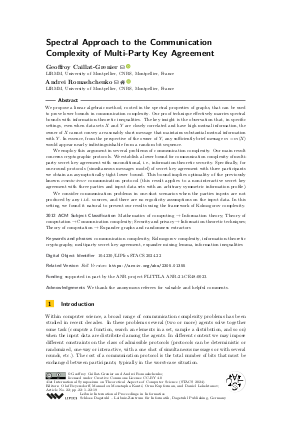@InProceedings{caillatgrenier_et_al:LIPIcs.STACS.2024.22,
author = {Caillat-Grenier, Geoffroy and Romashchenko, Andrei},
title = {{Spectral Approach to the Communication Complexity of Multi-Party Key Agreement}},
booktitle = {41st International Symposium on Theoretical Aspects of Computer Science (STACS 2024)},
pages = {22:1--22:19},
series = {Leibniz International Proceedings in Informatics (LIPIcs)},
ISBN = {978-3-95977-311-9},
ISSN = {1868-8969},
year = {2024},
volume = {289},
editor = {Beyersdorff, Olaf and Kant\'{e}, Mamadou Moustapha and Kupferman, Orna and Lokshtanov, Daniel},
publisher = {Schloss Dagstuhl -- Leibniz-Zentrum f{\"u}r Informatik},
address = {Dagstuhl, Germany},
URL = {https://drops.dagstuhl.de/entities/document/10.4230/LIPIcs.STACS.2024.22},
URN = {urn:nbn:de:0030-drops-197323},
doi = {10.4230/LIPIcs.STACS.2024.22},
annote = {Keywords: communication complexity, Kolmogorov complexity, information-theoretic cryptography, multiparty secret key agreement, expander mixing lemma, information inequalities}
}

 Creative Commons Attribution 4.0 International license
Creative Commons Attribution 4.0 International license



